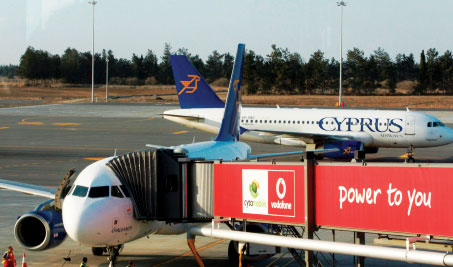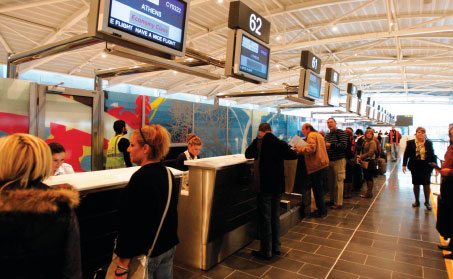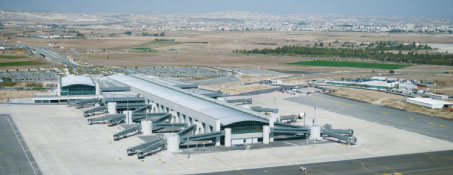The 25-year Build-Operate-Transfer (BOT) concession agreement awarded by the Cypriot government to Hermes Airports Consortium in 2006 to develop both airports has brought investment in excess of €640 million in construction of a new passenger terminal building at each site and other associated infrastructure, including aprons and runway extensions.

The first flight to arrive at the new Larnaka Airport was a Cyprus Airways service from Amman. As part of the Build-Operate-Transfer project, Cyprus Airways and easyJet were the first to transfer their services over to the new terminal on 10 November, with the remaining carriers following one week later.
Following seven successful operational trials, on 7 November, around 2,000 people attended the much-anticipated opening of the new terminal at Larnaka Airport. Alfred van der Meer, CEO, Hermes Airports, speaking at the opening press conference, said: “In just under four years, the dream of building and operating two world class airports on this beautiful island has finally become a reality.”
He added: “The opening of the new terminal in the midst of a global economic recession affects all of us and intensifies the challenge of meeting business objectives, establishing better connections and improving services to the travelling public. This requires intense cooperation between the public and private sectors, cooperation between airlines, ground handlers, state authorities and other stakeholders, but most of all it means we need strong teamwork between the people working at the airport.”

This partnership can be seen across Hermes Airports’ nine Cypriot and foreign shareholders, who bring local and international expertise to the airports. One of the shareholders, Vancouver Airport Services, is the leader in providing management services for the length of the agreement and acted on behalf of Hermes in overseeing the design and build contractor during the expansion of Larnaka and Pafos airports.
Under the contract with Hermes, Vancouver Airport Services – which manages 18 airports around the world – was responsible for bringing together qualified personnel, including Hermes CEO Alfred van der Meer, to manage and operate Larnaka Airport, as well as ensuring staff were ready for operations at both Pafos and Larnaka.
George Casey, president and CEO of Vancouver Airport Services, said: “This new terminal will help to further position Cyprus as a competitive tourist destination. We’re proud to be a contributor to this milestone project for the country of Cyprus and we’re particularly proud that we helped instil a Cypriot ‘Sense of Place’ into the design.”
Operations began on 10 November with flights served initially by Cyprus Airways and easyJet and from 17 November the remaining airlines transferred their services to the new terminal.
The new terminal is located approximately 500 metres away from the old terminal and is three times bigger. It can now serve 7.5 million passengers annually – an increase of more than 50%.
Of the new facilities, there are 16 air bridges, 67 check-in counters and five baggage carousels. A new 130,000sqm taxiway and new 170,000sqm apron have also been built.
The new airport will significantly improve the passenger experience, as well as serve as the island’s gateway, explained van der Meer. “This impressive state of the art structure will enable the airport community to provide travellers with a sense of place and comfort, allowing them to pass their time in a pleasant and friendly environment, and at the same time conveying the warm hospitality of Cyprus.”

Larnaka now has capacity for 7.5 million annual passengers and this can be further increased to 9 million in the longer-term. While the previous terminal had no airbridges, there are now 16.
New Pafos: one year on
The opening of Pafos’ new terminal last November was part of a 25-year Build-Operate-Transfer (BOT) contract with French firm Bouygues Bâtiment International, as the design and build contractor. It also formed part of a country-wide programme to upgrade air travel in the central tourist belt of Cyprus.
Architects Pascall + Watson and Stantec worked as part of the project team and were responsible for testing the initial project design to maximise operational performance, consider lifecycle impacts and deliver a cost-effective phasing programme.

Olivier Baric, general manager, Pafos Airport: “In the long-term, we are trying to differentiate Pafos from Larnaka for airport services as they serve different markets. Our main objective is to generate more winter traffic and we are targeting the growing markets of Russia and Eastern Europe. The long-term forecast for us is 3.5% year-on-year growth.”
Construction of the 18,000sqm passenger terminal was designed with the assumption that two million passengers would be handled in 2009. One year on, Olivier Baric, general manager, Pafos Airport, said: “Ironically, the breath of fresh air provided by the new terminal building was simultaneous with the first drop in traffic experienced here. By the end of this year we expect a little over one and a half million throughput; Pafos has been impacted more than Larnaka by the downturn because of its higher proportion of UK-related traffic. This, combined with route and fleet rationalisation resulting from the TUI/First Choice and Thomas Cook/My Travel mergers, has led to a 10% drop in traffic this year.”
Despite the fall in passenger numbers, Baric explained that the new terminal has been an operational success. “All systems have been running smoothly – largely attributed to the intensive Operational Readiness and Transfer (ORAT) phase that was in place.”
Retail space in the terminal building accounts for 2,500sqm of floor space and 26% of total revenues are generated by non-aeronautical activities, explained Baric. “We are striving at increasing this proportion with our retail and F&B partners by minimising dwell times as much as feasible,” he said. “In the long-term, we are trying to differentiate Pafos from Larnaka for airport services as they serve different markets. Our main objective is to generate more winter traffic, as Cyprus is a great all-year-round sunny destination. In addition, we are targeting the growing markets of Russia and Eastern Europe. But all-in-all, the long-term forecast for us is 3.5% year-on-year growth.”







